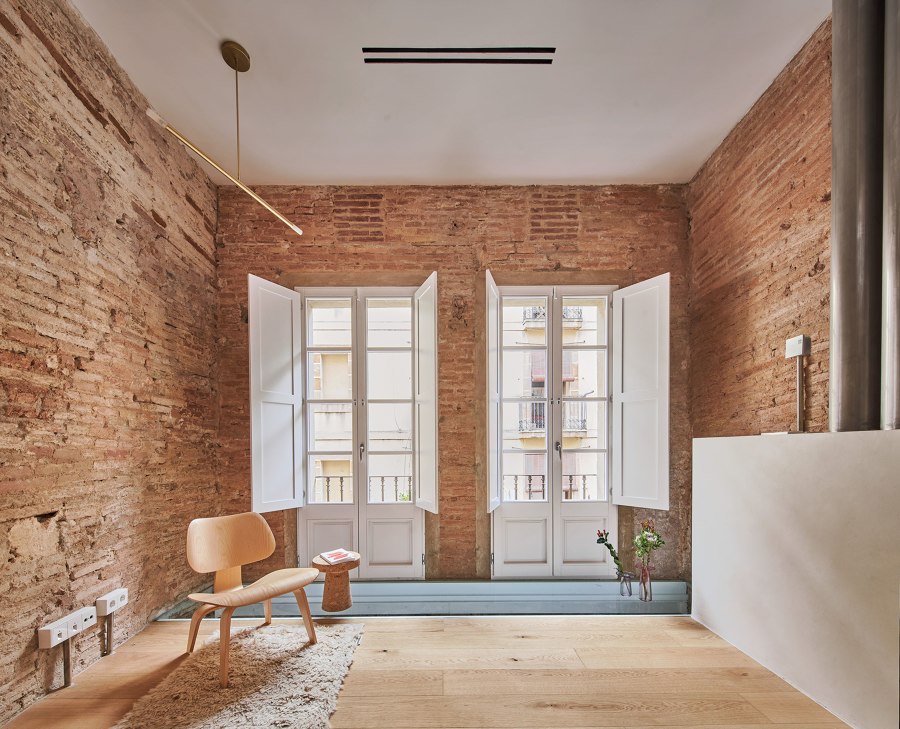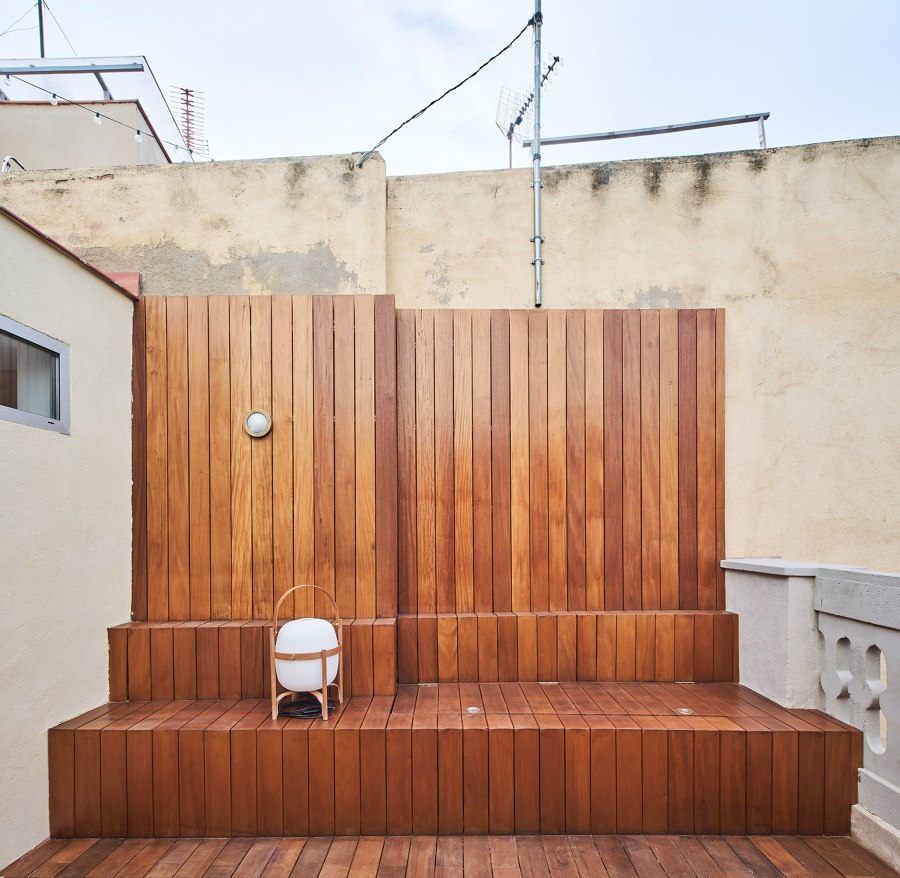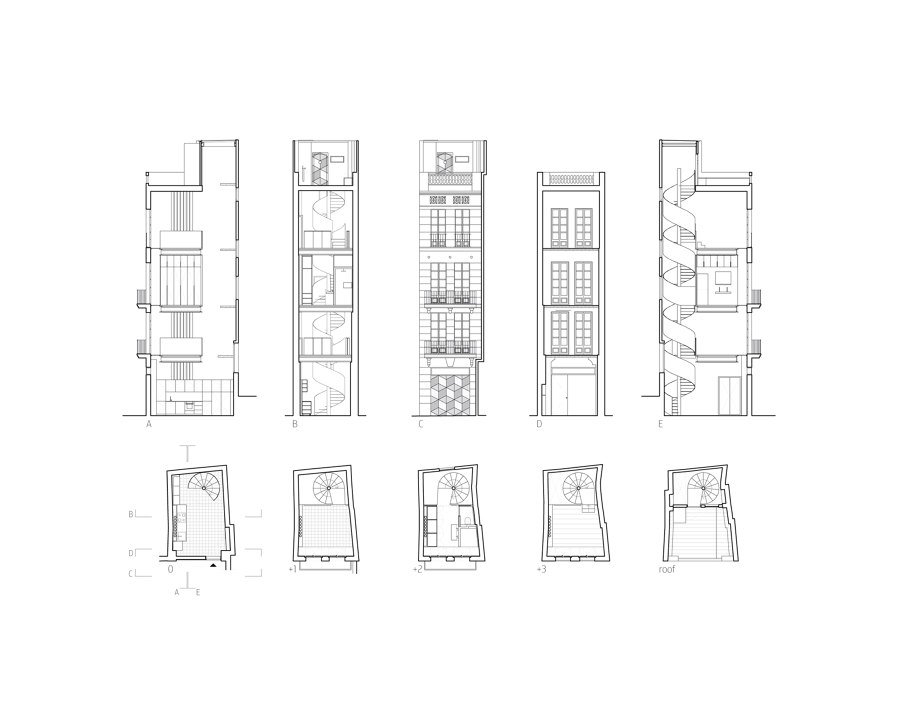
Photographer: José Hevia

Photographer: José Hevia

Photographer: José Hevia
This complex project began 8 years ago, going through all kinds of situations: squats, regulatory disagreements, changes in use, slow and complicated work...although the client's desire to leave the walls with exposed brick and using hydraulic mosaic (the cliché of Barcelona) remained unalterable. In addition, the requirements were to convert this small building located in the Borne district of Barcelona, from the end of the 19th century and with 4 floors (but barely 20sqm per floor), into a place where to be able to work and spend short stays in their visits to Barcelona, although, along these 8 years, the personal and family situation of the client has changed, to which the project has adapted.
The original situation of the property was in ruins, with very damaged floor slabs, weak stairs, parts of them demolished . Added to this was the need to adapt the building to current regulations, which made it practically impossible from the start to reuse the interior, proceeding to completely demolish the building, maintaining only the facades and dividing walls, and the roof slab (not the stair tower, which was rebuilt).
The construction process, slow and complex, at least allowed decisions to be made as the essence of the estate was revealed with the demolitions. Thus, once all the floors slabs had been demolished and the building was seen as a slender and tall prism formed by walls with a completely heterogeneous composition of all kinds of bricks and stones arranged without apparent order or composition, the idea of leaving all these walls exposed became conceptual: these four walls, over 15m high, are a museum of the building's history, where any trace of its construction (arches, lintels, stairs and beams), and of its use (mortar remains , furnishings, claddings..) will be left unaltered, exposed in all its crudeness. The new floors (3 in total) will be supported by new beams between the dividing walls, which will not touch either of the two facades: towards the main facade, a sheet of glass will separate them from it; and towards the interior façade, the stairwell will be a 4-story void that unites the entire interior and shows the surprising height of such a slender building. Thus, the project is defined, remaining to define the uses of each floor and resolve the technical issues.
Access-kitchen-dining room, living room, bathroom-dressing room, bedroom and terrace form, from bottom to top, the sequence of use. In any case, with the exception of kitchen furniture and bathroom equipment, nothing else occupies the floors, so that their uses can be reversed over time or need, as well as turning the floors into working spaces.
The presence of the installations, by ruling out grooves in the walls or small wells from the beginning, take on a special and relevant role inside: 7 stainless steel cylinders run the entire height of the building, conducting all the electrical, ventilation, plumbing, extraction, sanitation, air conditioning and telecommunications installations inside 6 of the cylinders, leaving one of them empty for future needs.
These cylinders are not hidden and run through the building through furniture and floors. The rest of the installations are always visible, never built-in, highlighting the roughness of the masonry walls on which they are located, freeing them from new servitudes.
In terms of materiality, a certain refinement has been pursued in the new elements to be implemented, in opposition to the crude expressiveness of the existing walls, conscious that the space must house a home. Thus, the kitchen is a frosted brass piece of furniture, shiny and with reflections, with a white marble top; the bathroom equipment is paneled with lacquered wood in a slightly cream color, with black and brass details; the 'headboards' of the floors are covered in white microcement; the hydraulic mosaic, microcement and oak floors add warmth and color to the interior; and the lacquered wood ceilings incorporate registers and grids to 'design' these needs.
The structure is all painted white, in search of a certain material abstraction, especially in the development of the spiral staircase, which is developed as a free-standing cylinder that runs the entire height of the building without touching its walls at any time, offering Piranesian views helped by the heterogeneity of the walls and the diversity of points of view.
On the contrary, all the details on the existing walls are direct and raw: the window frames are made with direct mortar, the pre-frames are not concealed, and the structural elements of ties are left unpolished.
Above, on top of the stairwell, a skylight introduces a beautiful gradation of light until the lowest strata; towards the façade, the glass sheets bounce the lighting between floors and introduce ever-changing reflections, allowing the façade to be admired at its full height from the inside, just as it happens in the void of the staircase.
The main façade was rehabilitated following the strict dictates of the heritage department, returning it to an image of the past that it surely never had. Only at the entrance door were we free to invent a front that reproduces the three-dimensional design of the classic hydraulic mosaic (used on the ground floor and much loved by the client) with an exploded view of rhombuses and triangles finished with 3 types of aluminum, which conceals the door (only recognizable by the lock) and abstracts the entrance.
Design team:
Raúl Sánchez
Architecture: Valentina Barberio
Structure consultant: Diagonal Arquitectura
Engineering: Marés ingenieros

Photographer: José Hevia

Photographer: José Hevia

Photographer: José Hevia

Photographer: José Hevia

Photographer: José Hevia

Photographer: José Hevia

Photographer: José Hevia

Photographer: José Hevia

Photographer: José Hevia

Photographer: José Hevia

Photographer: José Hevia

Photographer: José Hevia


















